失效安全型湿式多盘制动器设计
- 格式:doc
- 大小:55.50 KB
- 文档页数:6
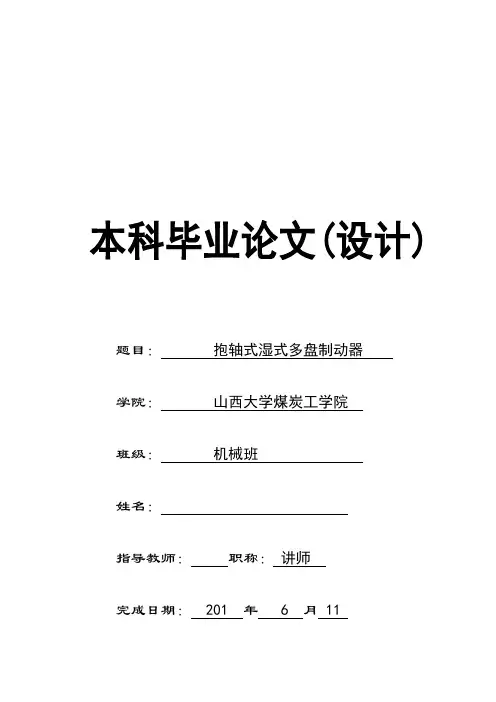
本科毕业论文(设计)题目:抱轴式湿式多盘制动器学院:山西大学煤炭工学院班级:机械班姓名:指导教师:职称:讲师完成日期: 201 年 6 月 11抱轴式全封闭湿式多盘式制动器设计摘要:无轨胶轮车辅助运输,是我国煤矿生产中重要的运输方式。
因此,湿式多盘制动器就成为了目前研究的重要课题。
本文通过对不同种类制动器的作用、分类、结构以及原理的详细介绍,找出了湿式多盘制动器的优势,进一步分析了湿式多盘制动器的工作原理。
结合本课题无轨辅助运输设备所需的制动性能,根据常规全封闭湿式多盘制动器的结构特点和其工作原理,通过详细计算及校核设计出符合无轨胶轮车辅助运动车辆的制动器。
关键字:湿式多盘制动器;制动力矩;碟簧IThe Design of Fully Enclosed Wet Multi-disc BrakeAbstract:The trackless assisted transportation is an important transport in China's coal production , therefore wet multi-disc brake has become an important topic. The paper introduce the function, classification, structure and working principle of all kinds of brake. Further analysis the advantages of a wet multi-disc brake and how it works. With rail auxiliary transport equipment required braking performance of the subject. According to the structural characteristics of the Practices fully enclosed wet multi-disc brake and its working principle. Through the detailed, In conformity with the supplementary we should design motor vehicles rubber-tyred car brake.Key words:Wet multi-disc brake;Braking torque;Disc spring目录第一章绪论 (1)1.1 课题背景 (1)1.2 国内外现状 (1)1.2.1 国外现状 (1)1.2.2 国内现状 (2)1.3 工程车辆制动器的发展方向 (3)1.4 湿式多盘制动器研究的意义 (4)第二章制动系统的制动器要求和制动器的比较 (5)2.1 制动器的类型和比较 (5)2.2.1 制动器的类型 (5)2.2.2 制动器的性能比较 (5)第三章湿式多盘制动器概述 (7)3.1 湿式多盘制动器的现状、种类及特点 (7)3.2 湿式多盘制动器结构特点及其工作原理 (8)3.3 湿式多盘制动器的工作原理 (8)3.4 湿式多盘制动器冷却方式及散热途径 (9)第四章抱轴式湿式多盘制动器的设计 (10)4.1 设计的原始数据 (10)4.2 汽车制动理论分析 (10)4.2.1 制动性能的概念 (10)4.2.2 制动器性能评价指标 (10)4.2.3 制动时车辆受力分析 (11)4.2.4 制动车辆制动效能 (13)4.2.5 制动器制动力的比例关系 (14)4.3 湿式多盘制动器的计算 (15)4.3.1 全封闭湿式多盘制动器的原始数据 (15)4.3.2 全封闭湿式多盘制动器的设计原则 (16)M的计算 (17)4.3.3 整车所需的最大制动力矩BT (18)4.3.4 前后桥制动器所需的力矩u4.3.5 前后桥制动器所需的制动力 (18)4.4 碟簧的计算及校核 (19)4.4.1 碟簧形式的选取 (19)4.4.2 碟簧的工作特点 (20)4.4.3 碟簧的种类 (20)4.4.3 复合碟簧的计算 (21)4.4.5 碟簧方案的选取 (22)4.4.6 碟簧方案的校核 (25)4.4.7 碟簧组设计方案的有关数据 (31)4.5 湿式多盘制动器摩擦材料的选择 (32)4.5.1 两种类型的摩擦材料 (32)4.5.2 结论 (32)4.6 花键的计算与校核 (33)4.6.1 花键的选择 (33)4.6.2 活塞上花键的参数计算与校核 (33)4.7 摩擦片选取及布置 (39)4.8.1 O 形密封圈的特点 (40)4.8.2 形密封圈对湿式多片制动器的影响 (41)4.9 湿式多盘制动器典型零件的设计与加工工艺 (41)第五章机械工程CAD制图规则 (45)第六章总结 (49)参考文献 (50)致谢 (51)附录 (52)英语文献 (1)中文翻译 (12)第一章绪论1.1 课题背景湿式多盘制动器具有制动力矩大、使用寿命长、抗衰退能力强、免维修等很多特点。
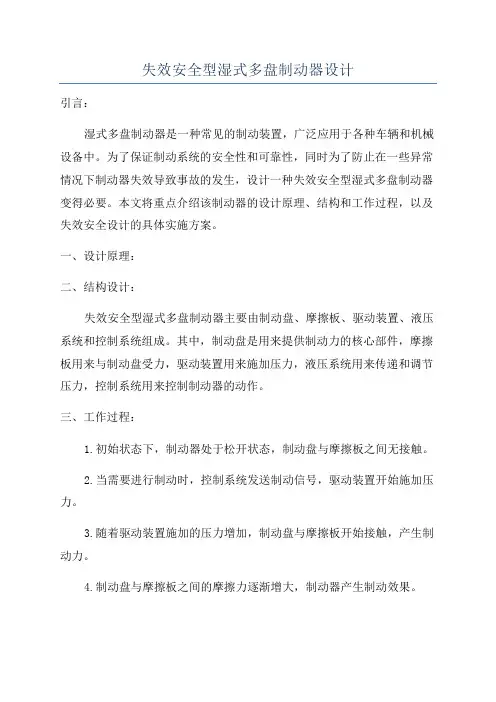
失效安全型湿式多盘制动器设计引言:湿式多盘制动器是一种常见的制动装置,广泛应用于各种车辆和机械设备中。
为了保证制动系统的安全性和可靠性,同时为了防止在一些异常情况下制动器失效导致事故的发生,设计一种失效安全型湿式多盘制动器变得必要。
本文将重点介绍该制动器的设计原理、结构和工作过程,以及失效安全设计的具体实施方案。
一、设计原理:二、结构设计:失效安全型湿式多盘制动器主要由制动盘、摩擦板、驱动装置、液压系统和控制系统组成。
其中,制动盘是用来提供制动力的核心部件,摩擦板用来与制动盘受力,驱动装置用来施加压力,液压系统用来传递和调节压力,控制系统用来控制制动器的动作。
三、工作过程:1.初始状态下,制动器处于松开状态,制动盘与摩擦板之间无接触。
2.当需要进行制动时,控制系统发送制动信号,驱动装置开始施加压力。
3.随着驱动装置施加的压力增加,制动盘与摩擦板开始接触,产生制动力。
4.制动盘与摩擦板之间的摩擦力逐渐增大,制动器产生制动效果。
5.当控制系统停止发送制动信号时,制动器停止施加压力,制动盘与摩擦板之间的接触解除,制动器恢复松开状态。
四、失效安全设计:在设计失效安全型湿式多盘制动器时,需要考虑以下几个方面:1.失效检测:通过安装传感器,监测制动器的压力或其他相关参数,当检测到异常情况时,及时发出警报或关闭制动器装置。
2.冗余设计:采用多个制动盘和摩擦板,使得即使一些盘片或摩擦板失效,其他盘片或摩擦板仍然可以正常工作,确保制动器的可靠性。
3.系统监控:通过控制系统对制动器的工作状态进行监测和控制,及时发现并处理制动器的异常情况,保证制动器系统的安全性和可用性。
4.备用系统:在关键部件或系统中设置备用装置,以防止因一些部件或系统失效而导致整个制动器失效。
五、结论:失效安全型湿式多盘制动器设计是为了保证制动系统的安全性和可靠性,在设计上应考虑失效检测、冗余设计、系统监控和备用系统等因素。
只有通过不断改进设计和严格控制制造过程,才能设计出高性能、高安全性和高可靠性的制动系统。
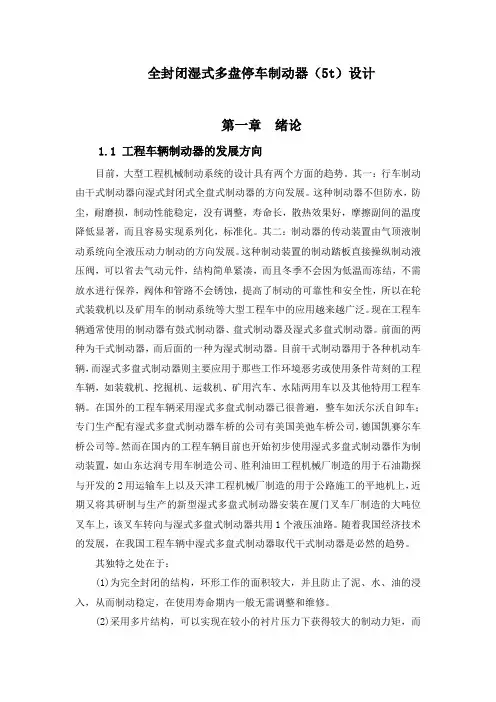
全封闭湿式多盘停车制动器(5t)设计第一章绪论1.1 工程车辆制动器的发展方向目前,大型工程机械制动系统的设计具有两个方面的趋势。
其一:行车制动由干式制动器向湿式封闭式全盘式制动器的方向发展。
这种制动器不但防水,防尘,耐磨损,制动性能稳定,没有调整,寿命长,散热效果好,摩擦副间的温度降低显著,而且容易实现系列化,标准化。
其二:制动器的传动装置由气顶液制动系统向全液压动力制动的方向发展。
这种制动装置的制动踏板直接操纵制动液压阀,可以省去气动元件,结构简单紧凑,而且冬季不会因为低温而冻结,不需放水进行保养,阀体和管路不会锈蚀,提高了制动的可靠性和安全性,所以在轮式装载机以及矿用车的制动系统等大型工程车中的应用越来越广泛。
现在工程车辆通常使用的制动器有鼓式制动器、盘式制动器及湿式多盘式制动器。
前面的两种为干式制动器,而后面的一种为湿式制动器。
目前干式制动器用于各种机动车辆,而湿式多盘式制动器则主要应用于那些工作环境恶劣或使用条件苛刻的工程车辆,如装载机、挖掘机、运载机、矿用汽车、水陆两用车以及其他特用工程车辆。
在国外的工程车辆采用湿式多盘式制动器已很普遍,整车如沃尔沃自卸车;专门生产配有湿式多盘式制动器车桥的公司有美国美弛车桥公司,德国凯赛尔车桥公司等。
然而在国内的工程车辆目前也开始初步使用湿式多盘式制动器作为制动装置,如山东达润专用车制造公司、胜利油田工程机械厂制造的用于石油勘探与开发的2用运输车上以及天津工程机械厂制造的用于公路施工的平地机上,近期又将其研制与生产的新型湿式多盘式制动器安装在厦门叉车厂制造的大吨位叉车上,该叉车转向与湿式多盘式制动器共用1个液压油路。
随着我国经济技术的发展,在我国工程车辆中湿式多盘式制动器取代干式制动器是必然的趋势。
其独特之处在于:(1)为完全封闭的结构,环形工作的面积较大,并且防止了泥、水、油的浸入,从而制动稳定,在使用寿命期内一般无需调整和维修。
(2)采用多片结构,可以实现在较小的衬片压力下获得较大的制动力矩,而元件承受的压力降低,摩擦片的单位面积受压力小。
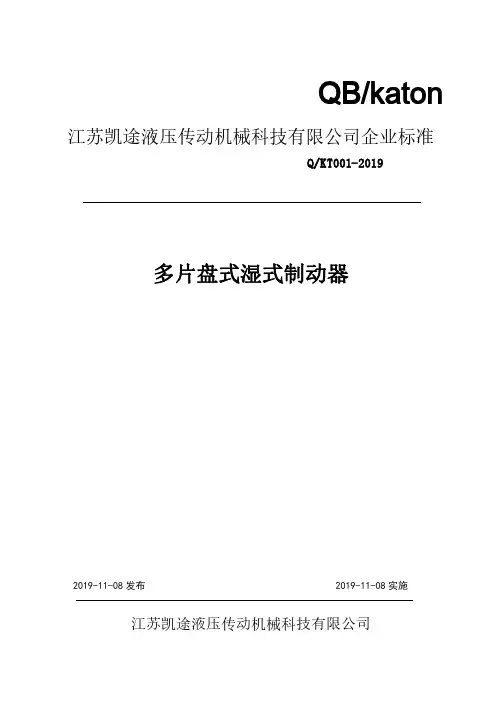
QB/katon 江苏凯途液压传动机械科技有限公司企业标准Q/KT001-2019多片盘式湿式制动器2019-11-08发布2019-11-08实施江苏凯途液压传动机械科技有限公司前言为规定公司的产品需要满足的要求,以保证产品适用性,特制订本企业产品标准。
本标准依据GB7258-2017机动车运行安全技术条件等标准编制。
编写规则符合GB/T1.1-2009标准化工作导则第1部分:标准的结构和编写和GB/T1.1-2009标准化工作导则第2部分:标准中规范性技术要求要素内容的确定方法。
本标准由江苏凯途液压传动机械科技有限公司技术部门提出。
本标准由江苏凯途液压传动机械科技有限公司技术部门负责解释。
本标准由江苏凯途液压传动机械科技有限公司技术部门归口。
本标准主要起草人:叶强、李信民、孙敦伟、梁存盼。
本标准为首次发布。
多片盘式湿式制动器1范围本标准规定了轮胎式机械多片盘式湿式制动器的术语和定义、型式、主要参数、要求、试验方法、检验规则、标志、包装、运输和贮存等内容。
本标准适用于轮胎式车辆制动系中的多片盘式湿式制动器,供本公司湿式制动器系列产品和经营中使用。
2、规范性引用文件下列文件对于本文件的应用是必不可少的。
凡是注日期的引用文件,仅注日期的版本适用于本文件;凡是不注日期的引用文件,其最新版本适用于本文件。
GB16423-2006金属非金属矿山安全规程GB7258-2012机动车运行安全技术条件GB/T1239.2冷卷圆柱螺旋弹簧技术条件第2部分:压缩弹簧GB/T23934热卷圆柱螺旋压缩弹簧技术条件GB/T1972碟形弹簧GB/T13384机电产品包装通用技术条件QC-T239-2015商用车辆行车制动器技术要求及台架试验方法JB-T8293浮动油封JB-T13003地下轮胎式矿用车辆驱动桥MT/T989矿用防爆柴油机无轨胶轮车通用技术条件3、术语和定义下列术语和定义适用于本文件。
3.1盘式制动器用圆盘的端面作为摩擦副接触面的制动器。
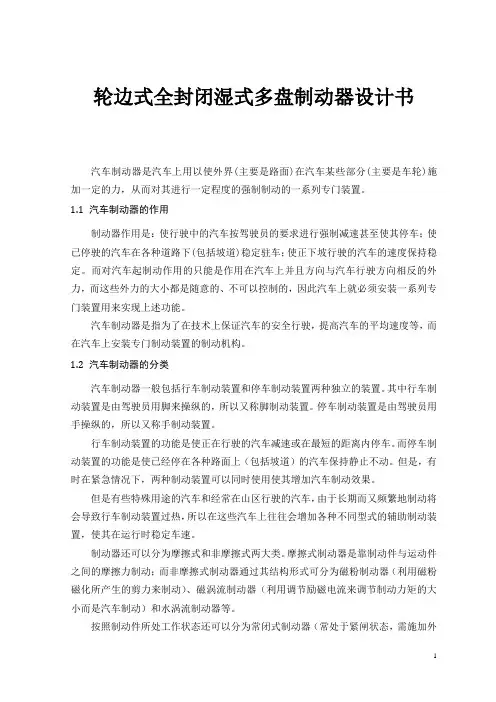
轮边式全封闭湿式多盘制动器设计书汽车制动器是汽车上用以使外界(主要是路面)在汽车某些部分(主要是车轮)施加一定的力,从而对其进行一定程度的强制制动的一系列专门装置。
1.1 汽车制动器的作用制动器作用是:使行驶中的汽车按驾驶员的要求进行强制减速甚至使其停车;使已停驶的汽车在各种道路下(包括坡道)稳定驻车;使正下坡行驶的汽车的速度保持稳定。
而对汽车起制动作用的只能是作用在汽车上并且方向与汽车行驶方向相反的外力,而这些外力的大小都是随意的、不可以控制的,因此汽车上就必须安装一系列专门装置用来实现上述功能。
汽车制动器是指为了在技术上保证汽车的安全行驶,提高汽车的平均速度等,而在汽车上安装专门制动装置的制动机构。
1.2 汽车制动器的分类汽车制动器一般包括行车制动装置和停车制动装置两种独立的装置。
其中行车制动装置是由驾驶员用脚来操纵的,所以又称脚制动装置。
停车制动装置是由驾驶员用手操纵的,所以又称手制动装置。
行车制动装置的功能是使正在行驶的汽车减速或在最短的距离内停车。
而停车制动装置的功能是使已经停在各种路面上(包括坡道)的汽车保持静止不动。
但是,有时在紧急情况下,两种制动装置可以同时使用使其增加汽车制动效果。
但是有些特殊用途的汽车和经常在山区行驶的汽车,由于长期而又频繁地制动将会导致行车制动装置过热,所以在这些汽车上往往会增加各种不同型式的辅助制动装置,使其在运行时稳定车速。
制动器还可以分为摩擦式和非摩擦式两大类。
摩擦式制动器是靠制动件与运动件之间的摩擦力制动;而非摩擦式制动器通过其结构形式可分为磁粉制动器(利用磁粉磁化所产生的剪力来制动)、磁涡流制动器(利用调节励磁电流来调节制动力矩的大小而是汽车制动)和水涡流制动器等。
按照制动件所处工作状态还可以分为常闭式制动器(常处于紧闸状态,需施加外力才可以解除制动)和常开式制动器(常处于松闸状态,需施加外力才可以进行制动)。
按照操纵方式可分为人力、液压、气压和电磁力操纵的制动器。
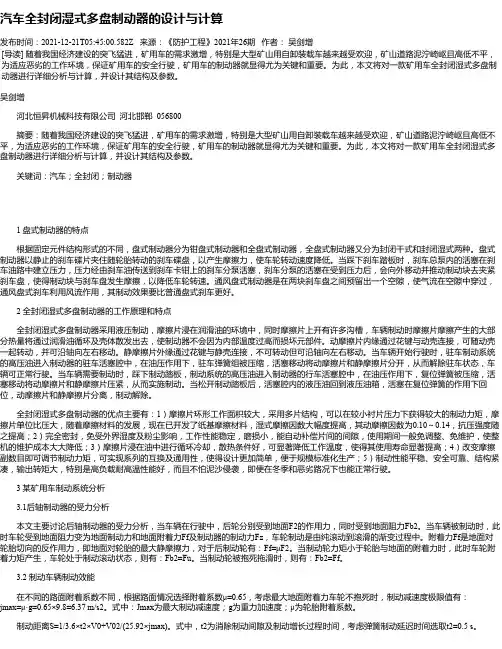
汽车全封闭湿式多盘制动器的设计与计算发布时间:2021-12-21T05:45:00.582Z 来源:《防护工程》2021年26期作者:吴剑增[导读] 随着我国经济建设的突飞猛进,矿用车的需求激增,特别是大型矿山用自卸装载车越来越受欢迎,矿山道路泥泞崎岖且高低不平,为适应恶劣的工作环境,保证矿用车的安全行驶,矿用车的制动器就显得尤为关键和重要。
为此,本文将对一款矿用车全封闭湿式多盘制动器进行详细分析与计算,并设计其结构及参数。
吴剑增河北恒昇机械科技有限公司河北邯郸 056800摘要:随着我国经济建设的突飞猛进,矿用车的需求激增,特别是大型矿山用自卸装载车越来越受欢迎,矿山道路泥泞崎岖且高低不平,为适应恶劣的工作环境,保证矿用车的安全行驶,矿用车的制动器就显得尤为关键和重要。
为此,本文将对一款矿用车全封闭湿式多盘制动器进行详细分析与计算,并设计其结构及参数。
关键词:汽车;全封闭;制动器1 盘式制动器的特点根据固定元件结构形式的不同,盘式制动器分为钳盘式制动器和全盘式制动器,全盘式制动器又分为封闭干式和封闭湿式两种。
盘式制动器以静止的刹车碟片夹住随轮胎转动的刹车碟盘,以产生摩擦力,使车轮转动速度降低。
当踩下刹车踏板时,刹车总泵内的活塞在刹车油路中建立压力,压力经由刹车油传送到刹车卡钳上的刹车分泵活塞,刹车分泵的活塞在受到压力后,会向外移动并推动制动块去夹紧刹车盘,使得制动块与刹车盘发生摩擦,以降低车轮转速。
通风盘式制动器是在两块刹车盘之间预留出一个空隙,使气流在空隙中穿过,通风盘式刹车利用风流作用,其制动效果要比普通盘式刹车更好。
2 全封闭湿式多盘制动器的工作原理和特点全封闭湿式多盘制动器采用液压制动,摩擦片浸在润滑油的环境中,同时摩擦片上开有许多沟槽,车辆制动时摩擦片摩擦产生的大部分热量将通过润滑油循环及壳体散发出去,使制动器不会因为内部温度过高而损坏元部件。
动摩擦片内缘通过花键与动壳连接,可随动壳一起转动,并可沿轴向左右移动。
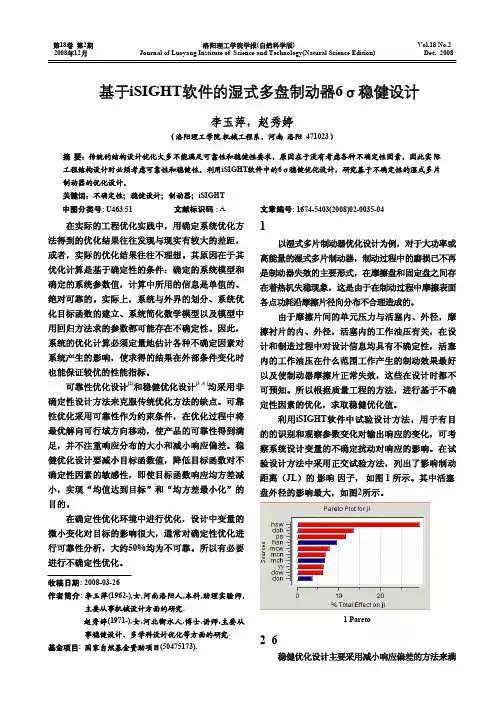
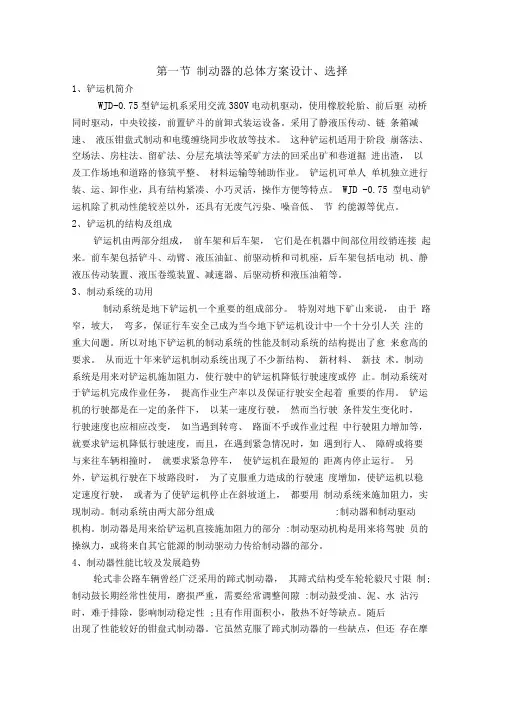
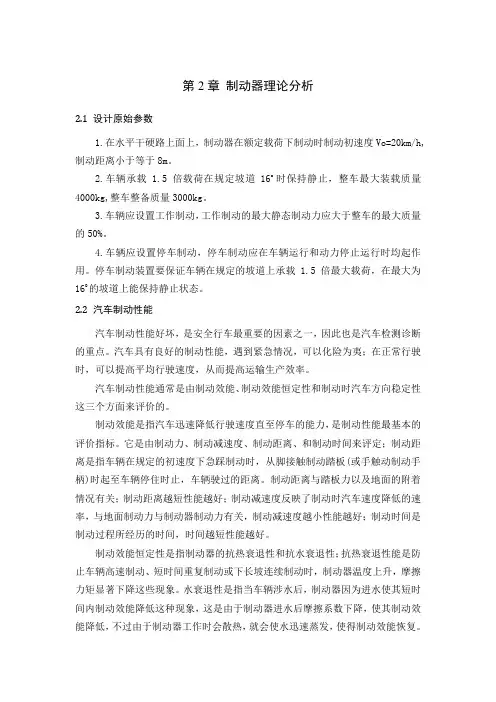
第2章制动器理论分析2.1 设计原始参数1.在水平干硬路上面上,制动器在额定载荷下制动时制动初速度Vo=20km/h,制动距离小于等于8m。
2.车辆承载 1.5倍载荷在规定坡道16o时保持静止,整车最大装载质量4000kg,整车整备质量3000kg。
3.车辆应设置工作制动,工作制动的最大静态制动力应大于整车的最大质量的50%。
4.车辆应设置停车制动,停车制动应在车辆运行和动力停止运行时均起作用。
停车制动装置要保证车辆在规定的坡道上承载 1.5倍最大载荷,在最大为16O的坡道上能保持静止状态。
2.2 汽车制动性能汽车制动性能好坏,是安全行车最重要的因素之一,因此也是汽车检测诊断的重点。
汽车具有良好的制动性能,遇到紧急情况,可以化险为夷;在正常行驶时,可以提高平均行驶速度,从而提高运输生产效率。
汽车制动性能通常是由制动效能、制动效能恒定性和制动时汽车方向稳定性这三个方面来评价的。
制动效能是指汽车迅速降低行驶速度直至停车的能力,是制动性能最基本的评价指标。
它是由制动力、制动减速度、制动距离、和制动时间来评定;制动距离是指车辆在规定的初速度下急踩制动时,从脚接触制动踏板(或手触动制动手柄)时起至车辆停住时止,车辆驶过的距离。
制动距离与踏板力以及地面的附着情况有关;制动距离越短性能越好;制动减速度反映了制动时汽车速度降低的速率,与地面制动力与制动器制动力有关,制动减速度越小性能越好;制动时间是制动过程所经历的时间,时间越短性能越好。
制动效能恒定性是指制动器的抗热衰退性和抗水衰退性;抗热衰退性能是防止车辆高速制动、短时间重复制动或下长坡连续制动时,制动器温度上升,摩擦力矩显著下降这些现象。
水衰退性是指当车辆涉水后,制动器因为进水使其短时间内制动效能降低这种现象,这是由于制动器进水后摩擦系数下降,使其制动效能降低,不过由于制动器工作时会散热,就会使水迅速蒸发,使得制动效能恢复。
制动时汽车方向稳定性是指制动时汽车按给定轨迹的行驶能力,即防止汽车制动时跑偏、侧滑和失去转向能力。
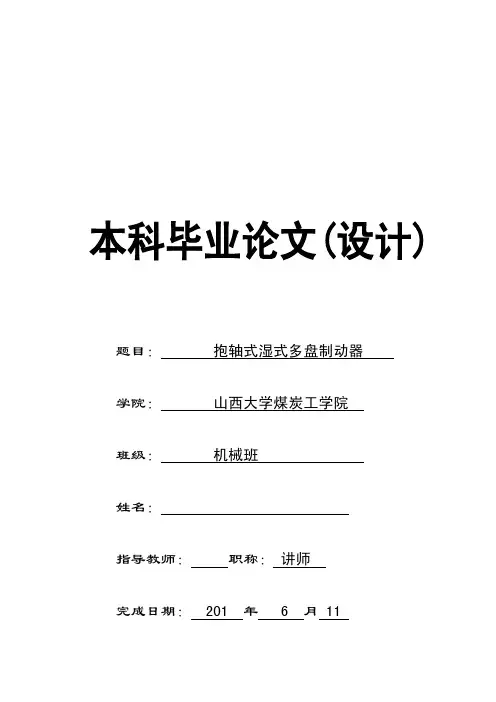
本科毕业论文(设计)题目:抱轴式湿式多盘制动器学院:山西大学煤炭工学院班级:机械班姓名:指导教师:职称:讲师完成日期: 201 年 6 月 11抱轴式全封闭湿式多盘式制动器设计摘要:无轨胶轮车辅助运输,是我国煤矿生产中重要的运输方式。
因此,湿式多盘制动器就成为了目前研究的重要课题。
本文通过对不同种类制动器的作用、分类、结构以及原理的详细介绍,找出了湿式多盘制动器的优势,进一步分析了湿式多盘制动器的工作原理。
结合本课题无轨辅助运输设备所需的制动性能,根据常规全封闭湿式多盘制动器的结构特点和其工作原理,通过详细计算及校核设计出符合无轨胶轮车辅助运动车辆的制动器。
关键字:湿式多盘制动器;制动力矩;碟簧IThe Design of Fully Enclosed Wet Multi-disc BrakeAbstract:The trackless assisted transportation is an important transport in China's coal production , therefore wet multi-disc brake has become an important topic. The paper introduce the function, classification, structure and working principle of all kinds of brake. Further analysis the advantages of a wet multi-disc brake and how it works. With rail auxiliary transport equipment required braking performance of the subject. According to the structural characteristics of the Practices fully enclosed wet multi-disc brake and its working principle. Through the detailed, In conformity with the supplementary we should design motor vehicles rubber-tyred car brake.Key words:Wet multi-disc brake;Braking torque;Disc spring目录第一章绪论 (1)1.1 课题背景 (1)1.2 国内外现状 (1)1.2.1 国外现状 (1)1.2.2 国内现状 (2)1.3 工程车辆制动器的发展方向 (3)1.4 湿式多盘制动器研究的意义 (4)第二章制动系统的制动器要求和制动器的比较 (5)2.1 制动器的类型和比较 (5)2.2.1 制动器的类型 (5)2.2.2 制动器的性能比较 (5)第三章湿式多盘制动器概述 (7)3.1 湿式多盘制动器的现状、种类及特点 (7)3.2 湿式多盘制动器结构特点及其工作原理 (8)3.3 湿式多盘制动器的工作原理 (8)3.4 湿式多盘制动器冷却方式及散热途径 (9)第四章抱轴式湿式多盘制动器的设计 (10)4.1 设计的原始数据 (10)4.2 汽车制动理论分析 (10)4.2.1 制动性能的概念 (10)4.2.2 制动器性能评价指标 (10)4.2.3 制动时车辆受力分析 (11)4.2.4 制动车辆制动效能 (13)4.2.5 制动器制动力的比例关系 (14)4.3 湿式多盘制动器的计算 (15)4.3.1 全封闭湿式多盘制动器的原始数据 (15)4.3.2 全封闭湿式多盘制动器的设计原则 (16)M的计算 (17)4.3.3 整车所需的最大制动力矩BT (18)4.3.4 前后桥制动器所需的力矩u4.3.5 前后桥制动器所需的制动力 (18)4.4 碟簧的计算及校核 (19)4.4.1 碟簧形式的选取 (19)4.4.2 碟簧的工作特点 (20)4.4.3 碟簧的种类 (20)4.4.3 复合碟簧的计算 (21)4.4.5 碟簧方案的选取 (22)4.4.6 碟簧方案的校核 (25)4.4.7 碟簧组设计方案的有关数据 (31)4.5 湿式多盘制动器摩擦材料的选择 (32)4.5.1 两种类型的摩擦材料 (32)4.5.2 结论 (32)4.6 花键的计算与校核 (33)4.6.1 花键的选择 (33)4.6.2 活塞上花键的参数计算与校核 (33)4.7 摩擦片选取及布置 (39)4.8.1 O 形密封圈的特点 (40)4.8.2 形密封圈对湿式多片制动器的影响 (41)4.9 湿式多盘制动器典型零件的设计与加工工艺 (41)第五章机械工程CAD制图规则 (45)第六章总结 (49)参考文献 (50)致谢 (51)附录 (52)英语文献 (1)中文翻译 (12)第一章绪论1.1 课题背景湿式多盘制动器具有制动力矩大、使用寿命长、抗衰退能力强、免维修等很多特点。
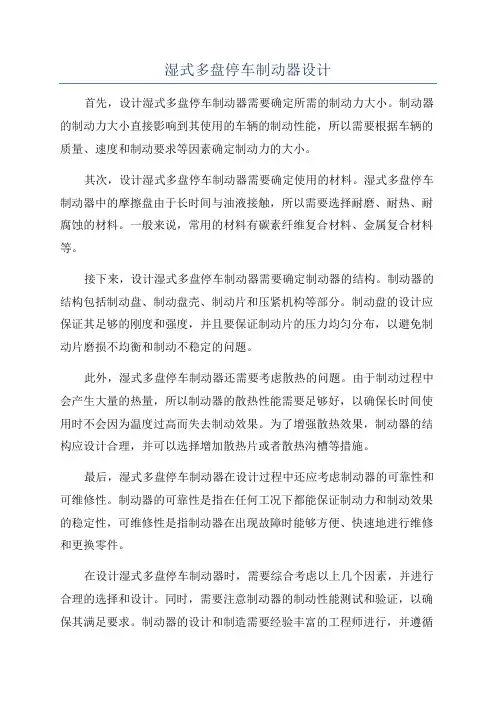
湿式多盘停车制动器设计首先,设计湿式多盘停车制动器需要确定所需的制动力大小。
制动器的制动力大小直接影响到其使用的车辆的制动性能,所以需要根据车辆的质量、速度和制动要求等因素确定制动力的大小。
其次,设计湿式多盘停车制动器需要确定使用的材料。
湿式多盘停车制动器中的摩擦盘由于长时间与油液接触,所以需要选择耐磨、耐热、耐腐蚀的材料。
一般来说,常用的材料有碳素纤维复合材料、金属复合材料等。
接下来,设计湿式多盘停车制动器需要确定制动器的结构。
制动器的结构包括制动盘、制动盘壳、制动片和压紧机构等部分。
制动盘的设计应保证其足够的刚度和强度,并且要保证制动片的压力均匀分布,以避免制动片磨损不均衡和制动不稳定的问题。
此外,湿式多盘停车制动器还需要考虑散热的问题。
由于制动过程中会产生大量的热量,所以制动器的散热性能需要足够好,以确保长时间使用时不会因为温度过高而失去制动效果。
为了增强散热效果,制动器的结构应设计合理,并可以选择增加散热片或者散热沟槽等措施。
最后,湿式多盘停车制动器在设计过程中还应考虑制动器的可靠性和可维修性。
制动器的可靠性是指在任何工况下都能保证制动力和制动效果的稳定性,可维修性是指制动器在出现故障时能够方便、快速地进行维修和更换零件。
在设计湿式多盘停车制动器时,需要综合考虑以上几个因素,并进行合理的选择和设计。
同时,需要注意制动器的制动性能测试和验证,以确保其满足要求。
制动器的设计和制造需要经验丰富的工程师进行,并遵循相应的标准和规范。
只有合理的设计和制造才能保证湿式多盘停车制动器的性能和安全。
总之,设计湿式多盘停车制动器需要考虑制动力大小、材料的选择、结构设计、散热性能、可靠性和可维修性等因素。
只有综合考虑这些因素,并进行合理的选择和设计,才能设计出满足要求的湿式多盘停车制动器。
Joint International Information Technology, Mechanical and Electronic Engineering Conference (JIMEC 2016)Principle and Design of Cooling System on multi-functionWet Type Multi-disk BrakesChuanwei Zhang ,Wang MiaoXi’an University of Science and Technology, China******************Keywords: multi-function Wet Type Multi-disk Brake; design; forcing cooling; Self-coolingAbstract.This paper presented types of wet brake, structure and principle of multi-function wet type multi-disk brake, focusing on its principle of cooling system and design of fully-closed multi-function multi-disk wet brake, as well as calculated and analyzed the cooling system of the vehicle brake on different kinds of cars.1 IntroductionDrum brake was for the first time applied in mechanical engineering, which adopted the sealing brake pads on the structure, so in the case of the repeated braking, the generated wear debris cannot be dissipated, resulting a great impact on the smooth degree of the brakes in the braking process. Afterwards, the disc brakes with superior braking performance appeared, but the caliper disc brakes had high friction surface pressure per unit area. Therefore, it required a higher anti-pressure ability for the friction disc material in the condition of high temperature. This for friction disc material in the case of large temperature compressive ability put forward higher requirements. At present, the more advanced brakes at home and abroad is wet brake, which is widely used in the mining machinery and engineering machinery. Wet brake is a kind of multi-disc brake, which friction element is enclosed within the brake shell. This brake has a stable braking performance and strong anti-pollution ability on the basis of the good performance of the previous at the front of the two types of brake. But this kind of brake must be equipped with a set of cooling system. If it is poorly designed the cooling system was designed improperly, the friction heat of the brake cannot be distributed in the continuous braking process, causing the temperature of the brake chamber rises and oil deterioration, braking performance degradation even cannot work[1-2]. Therefore, in order to ensure brake works safely and, its brake cooling system must be designed appropriately.2 The Structure And Principle Of Multi-function Wet Type Multi-disk BrakesAccording to the functions and working principle, wet brake is divided into some types, including Ordinary Wet Type Multi-disc Brake, Wet Multiple Disk Pressure Loss Brake, Multi-function Wet type Multi-disk Brake[3].The widely used wet brake in the mining machinery and engineering machinery is Multi-function Wet type Multi-disk Brake. The structure is shown in Fig.1.More than half of the brake friction plates area are immersed in the lubricating oil. Many grooves exist on the friction plates. Most of the heat in the brake friction plates generated by the friction will be dissipated through the lubricating oil and housing, avoiding the internal temperature rise too high and damage the brake component part.The brake integrated the function of Ordinary Wet Type Multi-disc Brake and Wet Multiple Disk Pressure Loss Brake, which realized the tri-function of driving brake, parking brake and emergency brake and do not need the second brake system.The internal splines and the spline shaft of the movable friction plates inner ring was connected through the spine, which can rotate along with the movable friction plates. The connection of the external splines of the static friction plates and brake shell was by splines. Movable friction plates and static friction plates arealternate arrangement and the driving brake and parking brake are respectively controlled by two different hydraulic oil. Driving braking force is produced by the hydraulic oil press on the driving brake piston surface. When the pressure oil comes into driving brake piston of oil chamber, the driving brake piston pushes static friction plates to press movable friction plates generating friction, then the wheels are braked. When the pressure of oil is relieved, return spring makes the driving brake piston depart from the static friction plates so that movable friction plates depart from the static friction plates, releasing the braking force.Fig. 1.Structure of Multi-functionWet Type Multi-diskBrakes1- screw; 2 - spring washer; 3 - connection housing; 4- spring plate; 5- squareflatand tight set screw 6- nut; 7-O-rings;8- rectangular cross-section spring; 9- parking brake piston; 10- collar; 11- star-ring; 12- the middle cylinder; 13- collar;14- star-ring; 15- driving brake piston; 16- collar; 17- star-ring; 18- skeleton Seal; 19- movable friction plate;20- static friction plate; 21- spring collar; 22- spline shaft; 23- floating oilseal.The parking brake force was generated by the rectangular cross-section spring. During driving, when the pressure oil in the oil chamber of the parking brake piston reached rated pressure, pressure oil pressed on the surface of the parking brake piston to make it out of the driving brake piston and compress the springs with rectangular section and movable friction plates depart from the static friction plates, following a non-parking brake status. When the parking brake or engine broke down or the tubing burst, the rectangular cross-section springs push the parking brake piston, thus the driving brake piston pushes static friction plates generating friction then wheels are braked, and ensured the security.3 The Wet Brake Cooling AnalysisThe totally enclosed multi-disc wet brake is mainly used the circulation of the fluid for cooling, which can be divided into forced cooling and self-cooling. For the forced cooling, the cooling oil is introduced into the brakes from the outside circulation, flows through the friction disk then flows out, taking away brake heat. Self-cooling is relied on the cooling oil in the brake and brake of the shell for cooling. Due to the different cooling, brake and bridge structures are different. It have a hub seal before the support bearing in forced cooling, while no in self-cooling. The structure of the forced cooling is complex, but it has a strong cooling ability. The structure of self-cooling is simple, while its cooling capacity is relatively weak. The cooling system is designed through the accurate calculation of the generated heat by the brake during braking and the removed heat by cooling oil, and radiated heat into the atmosphere by the brake surfaces. The flow rate of the cooling pump was determined by the balance of them[4].4 Calculation And Design Of The Cooling SystemThe consumed work of the friction moment between the fixed disc brake and friction plates is equal to the energy (E ) consumed by the truck's braking, and the truck's braking energy E is equal to the sum of the kinetic energy 1E and potential energy 2E of the vehicle, namely,212mgh mv E =E +E =+22 ()1 In the equation:E —The total heat generated when the vehicle braking , J ;1E —The kinetic energy generated during braking , J ;2E —Potential energy generated when the vehicle braking, J; v —Initial speed of the vehicle before braking ,m /s ;g —Acceleration of gravity ,2m /s ;h —The road slope height ,m ;m —The average mass of the vehicle, 12()/2m m m =+, kg ;1m —Mass of the empty vehicle, kg ;2m —Mass of the vehicle loaded with goods, kg .As the potential energy of the vehicle at top reaches the maximum, and is zero at the bottom of the hill, the potential energy takes the mean value while calculation, which is half of the value at top, when the slope is not too sharp,h LK ≈ ()2 L —the slope length , m ;K —slope, % .If the total running cycle of the vehicle is T .In this cycle, the number of braking is 1n at high speed 1v , and 2n at low speed 2v , then2211221n mv n mv E 22=+ ()3The total heat produced per minute for each brakeh LK ≈Assuming the ambient temperature around is 0t . The temperature of the oil flowing into the brake is 1t and the allowed temperature of the oil flowing out of brake is 2t . So a portion of the heat generated by the brakesupply the oil temperature rising from 1t to 2t , and the other dissipates into the atmosphere through the surfaceof the brake. Therefore,22121(-(-)Q t t C Q t t A ρμ=+) ()4 In the equation,1Q —The cooling ability of a brake ,J /min ;C —The specific heat capacity of the oil, usually take ()216.7420.9310/()C x J kg C =-︒;ρ—The density of oil, 3900kg /m ρ=;μ—The heat transfer coefficient of the brake, 2/(min J m C ⨯⨯︒); A —The cooling area of the brake ,2m ;Q —The flow rate of the cooling oil through a brake ,3m /min .According to heat balance, 12 Q Q =, the oil flow of each brake is obtained as follows:20204(-4(-E T t t A Q T t t C μρ-=)) ()5If 204(-0E T t t A μ-≤), the brake can adopt self-cooling, conversely forced cooling must be adopted in the brake.5 Forced Cooling LoopWet brakes are fully enclosed, which will generate a lot of heat in the brake. If there is no proper cooling system, the brake temperature quickly exceeds the rated temperature of the brake. At this time, the performance of the brake will drop, even be damaged. The selection of the cooling mode is based primarily on the balance of the braking strength and heat capacity. The cooling loop shown in Fig.2 can be an independent circuit, or connected to the other loop, such as steering circuit, but the pressure of the loop must be not more than 0.069 MPa. The pump flow can be calculated by the method. Here it is no longer accounted one by one in detail.Fig. 2.Cooling oil loop Example 1. According to the conclusions above, taking a mining car as an example, the car ran for 500m at the speed of 10 km /h on the ramp with slop angle of 12︒, in which 13600m kg =,25600m kg =,28v .m /s =,3T min =,027t C =︒,150t C =︒,280t C =︒,2465J /m s C μ=︒,204A .m =.Following the parameters provided above,1246002m m m kg +== ()6212137043222mgh mv E E E J =+=+= ()7 204(-4118040T t t A J μ=) ()8So, 204(-27476080E T t t A J μ-=-≤) ()9 According to the parameters provided above shows that 204(-0E T t t A μ-≤), the brake can adopt the way of self-cooled cooling. So the brake cooling system of the light vehicle widely used in the mine at present meet the design requirements.xample 2. As known the main parameters of the underground loader type:13500m kg =, 25100m kg =; 216v .m /s =, 12n =, 166v .m /s =, 22n =; 40L m =, 12K %=; 15T .min =, 027t C =︒, 180t C =︒, 290t C =︒,1243002m m m kg +== ()10 48h LK .m ≈= ()11 135260E J = ()12 1218523E E E J =+= ()13 The cooling area of the brake is taken 2 0 2 A .m =, the shell material is 45010QT -,and the coefficient of heat transfer is 21 380 J /(m min C )μ=⋅⋅︒Therefore, the total cooling capacity for the four brakes is204(-104328 T t t A J μ=) ()14 Due to 20434195E T t -t A J μ-=() ()15 The underground loader LW166 must use forced cooling.320204(-0.0036/min 3.5/min 4(-E T t t A Q m L T t t C μρ-===))()16Because the pump speed is 2400 r /min , the displacement of the pump is 3583 Q .cm /r =. The chosen pump with a displacement not less than 3583 .cm /r can meet the requirements [5].6 ConclusionsFrom the calculation and analysis above, we can judge when a self-cooling or forced cooling should be chosen in the different occasion in order to avoid the high manufacturing costs, which is brought by the forced cooling. If the reality was better than the assumptions, it proved that the flow rate of the hydraulic pump could meet the cooling requirements. On the contrary, the thermal balance should be recalculated and hydraulic pump should be re-elected to avoid the degradation of the braking performance or damage to brakes. References[1] Jianhua Yu, Principle and Design of Cooling System on Wet Type Multi-disk Brakes for Coal Mine [J]. Coal Mine Machinery, 2011, 11:25-26.[2] ZAGRODZKI Przemyslaw ,TRUNCONE Samuel A . Generation of Hot Spots in a Wet Multi-disk Clutch During Short Term Engagement [J ].Wear , 2003, 254: ( 5 /6) 474 - 491.[3] Chan D. Further developments of the wet braking system [C].International Conference -Braking,2004:225-239 .[4] Mengxiong Gao. Design of closed multiple disc wet brakes cooling system [J]. Mechanical Engineering, 1999, 02:21-22+49.[5] Daxian Cheng. Mechanical design manual [M]. Beijing: chemical industry press, 2002.。
无轨胶轮车湿式多盘失效安全型工作制动装置CHENG Jiansheng【摘要】对无轨胶轮车工作制动装置的构造原理进行了研究,在保证工作制动装置制动力不变的条件下,设计了一种无轨胶轮车湿式多盘失效安全型工作制动装置,该装置为失效安全型工作制动装置,通过液压回路对碟簧弹性力进行线性控制,改变制动装置动、静摩擦片贴合松紧度对无轨胶轮车实施制动和解除制动,既具备工作制动功能,又可以发挥失效安全型特性自动制动失控运行的车辆,从而提升无轨胶轮车行车安全,有效避免发生重大运输安全事故.%The construction principle of the working brake device of trackless rubber-tyred vehicle is studied in depth. Under the condition of guaranteeing the constant braking force of the working brake device, a wet multi-disk fail safety type working brake device for trackless rubber-tyred vehicle was invented and designed. The device is a fail safety type working brake device, which controls the elastic force of the disc spring linearly through the hydraulic circuit, and brakes the trackless rubber-tyred vehicle and removes the brake by changing the dynamic and static friction disc tightness. The device not only has the working brake function, but also can play the fail safety type characteristics to automatically brake vehicles running out of control, to ensure the safety of trackless rubber-tyred vehicles and avoid major transport safety accidents.【期刊名称】《煤矿安全》【年(卷),期】2019(050)006【总页数】3页(P125-127)【关键词】无轨胶轮车;工作制动装置;失效安全型;碟簧;线性控制【作者】CHENG Jiansheng【作者单位】Yanbei Coal Mine, Huating Coal Industry Group Co., Ltd., Huating 744100, China【正文语种】中文【中图分类】TD525按照《煤矿安全规程》要求,矿用无轨胶轮车工作制动必须采用湿式制动器。
山西大同大学工学院
毕业设计任务书
学院(系):机械工程系
专业:机械设计制造及其自动化
学生姓名:学号:
设计(论文)题目:失效安全型湿式多盘制动器设计
起迄日期: 2010年3月15日~ 2010年6月20
日
设计(论文)地点:山西大同大学工学院指导教师:王衍
专业负责人:杨玉璋
发任务书日期: 2010年3月15日
任务书填写要求
1.毕业设计(论文)任务书由指导教师根据各课题的具体情况填写,经学生所在专业的负责人审查、学院(系)领导签字后生效。
此任务书应在毕业设计(论文)开始前一周内填好并发给学生;
2.任务书内容必须用黑墨水笔工整书写或按教务处统一设计的电子文档标准格式(可从教务处网页上下载)打印,不得随便涂改或潦草书写,禁止打印在其它纸上后剪贴;
3.任务书内填写的内容,必须和学生毕业设计(论文)完成的情况相一致,若有变更,应当经过所在专业及学院(系)主管领导审批后方可重新填写;
4.任务书内有关“学院(系)”、“专业”等名称的填写,应写中文全称,不能写数字代码。
学生的“学号”要写全号(如020*******,为10位数),不能只写最后2位或1位数字;
5.有关年月日等日期的填写,应当按照国标GB/T 7408—94《数据元和交换格式、信息交换、日期和时间表示法》规定的要求,一律用阿拉伯数字书写。
如“2004年3月15日”或“2004-03-15”。
毕业设计任务书
毕业设计任务书
3.对毕业设计(论文)课题成果的要求〔包括毕业设计(论文)、图纸、实物样品等):
1)设计图电子版、设计说明书电子版;
2)设计图一份:包括装配图、零件图、工艺工艺过程卡;
3)设计说明书打印版
4)说明书缩编版(6000左右,电子版)
4.毕业设计(论文)课题工作进度计划:
起迄日期工作内容
2009年
3月16日~3月21日 3月22日~4月8日
4月 9日~6月14日6月17日~ 6月19日交毕业设计开题报告并进行审查和批准。
对开题报告进行必要的说明,讲解设计题目及相关的内容,到机械厂现场参观制动器设计和生产制造的相关内容,向现场工程师和工人师傅请教学习。
进行设计方案的构思或完成总体设计方案的确定。
进行具体技术设计并完成设计任务。
论文答辩与成绩评定。
所在专业审查意见:
负责人:
年月日系审查意见:
系领导:
年月日。